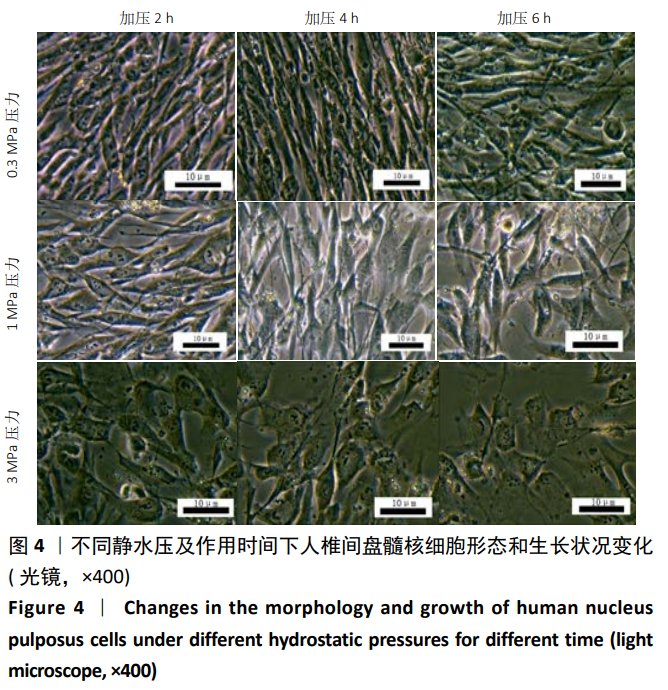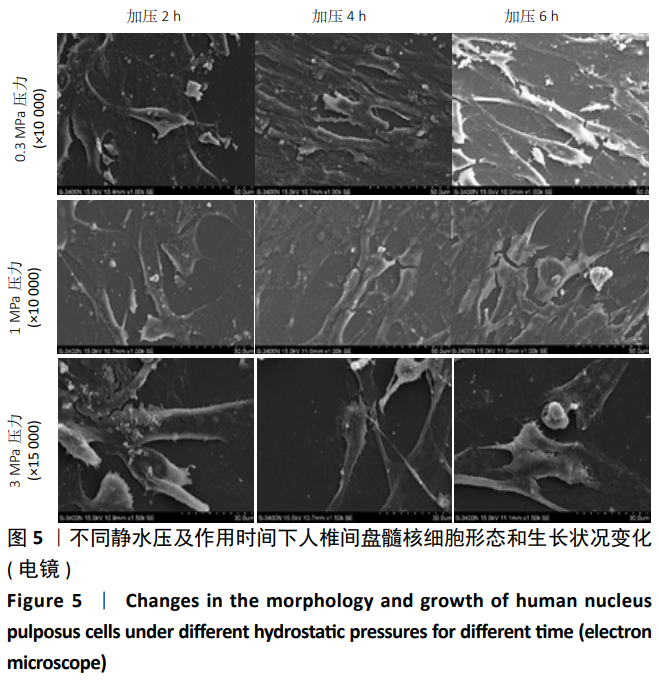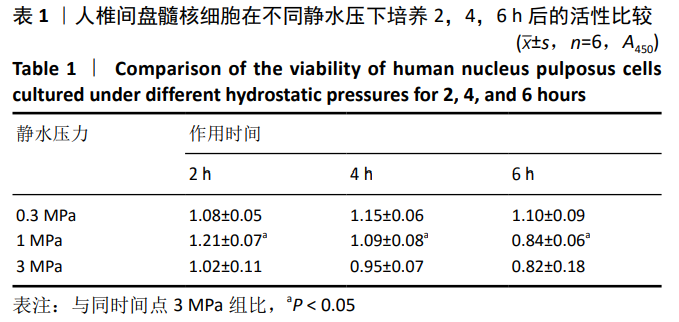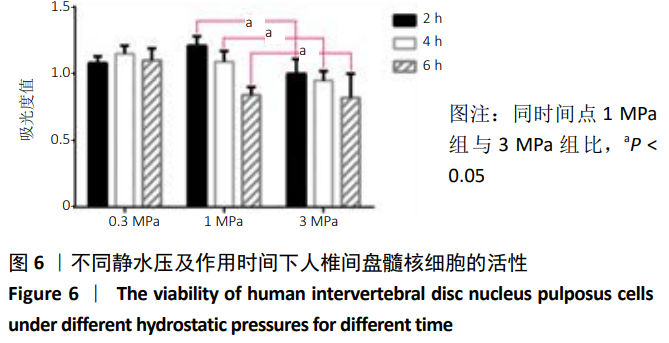中国组织工程研究 ›› 2021, Vol. 25 ›› Issue (8): 1172-1176.doi: 10.3969/j.issn.2095-4344.3036
• 脊柱组织构建 spinal tissue construction • 上一篇 下一篇
不同静水压下人椎间盘髓核细胞的形态和活性
刘志超1,2,张 帆3,孙 旗3,康晓乐3,袁巧妹3,柳根哲4,陈 江3,5
- 1中国中医科学院广安门医院南区骨一科,北京市 102600;2北京中医药大学,北京市 100029;3北京中医药大学东直门医院骨伤科一区,北京市 100700;4首都医科大学附属北京中医医院骨伤科,北京市 100010;5湖南中医药大学,湖南省长沙市 410208
Morphology and activity of human nucleus pulposus cells under different hydrostatic pressures
Liu Zhichao1, 2, Zhang Fan3, Sun Qi3, Kang Xiaole3, Yuan Qiaomei3, Liu Genzhe4, Chen Jiang3, 5
- 1Department of Orthopedics, Southern Branch of Guanganmen Hospital, China Academy of Chinese Medical Sciences, Beijing 102600, China; 2Beijing University of Chinese Medicine, Beijing 100029, China; 3Department of Orthopedics, Dongzhimen Hospital, Beijing University of Chinese Medicine, Beijing 100700, China; 4Department of Orthopedics, Beijing Traditional Chinese Medicine Hospital, Capital Medical University, Beijing 100010, China; 5Hunan University of Chinese Medicine, Hunan Province, China
摘要:
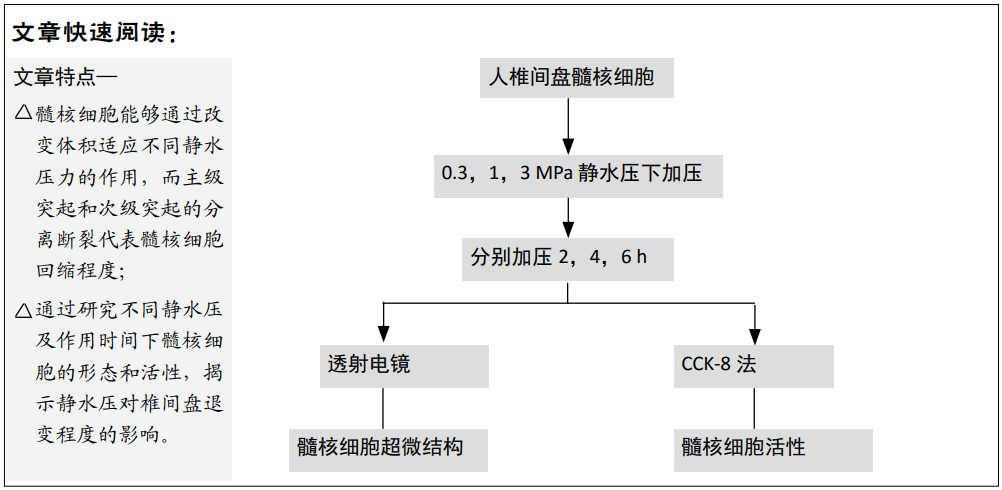
文题释义:
髓核:髓核在抵抗脊柱和椎间盘的负荷方面起着关键作用,其作用是产生一个静水压力,以均匀地分散圆盘内的负载。
静水压:是在人体内某部位聚集的液体受到应力刺激时对周围组织形成的压强。而椎间盘在人体运动时受到压应力在髓核中形成静水压,然后扩散至纤维环,由压应力转变成张应力。人平卧休息位时静水压最低约 0.3 MPa,坐位时接近 1 MPa, 弯腰搬重物可达 3 MPa。
背景:压应力能够引起细胞形态及活性的改变,但静水压下髓核细胞的形态和活性是否改变仍需进一步研究。
目的:研究体外静水压加载系统内人椎间盘髓核细胞形态和活性的变化。
方法:将人椎间盘髓核细胞分离培养并传3代后,在静水压加载系统0.3,1,3 MPa的静水压力环境下加压2,4,6 h后,使用倒置相差显微镜观察人椎间盘髓核细胞加压前后的形态变化及生长状况;采用透射电镜观察各组人椎间盘髓核细胞超微结构的变化及差异;使用CCK-8法检测不同静水压下人椎间盘髓核细胞的增殖活性的变化。
结果与结论:①细胞培养及传代:第1,2,3代人椎间盘髓核细胞的生长曲线呈S形,3-7 d时呈直线增殖,此阶段细胞生长最快、活力最高;第5,6代人椎间盘髓核细胞的突起呈长梭形,成长较慢,出现退化;②细胞形态:在0.3,1,3 MPa的静水压下人椎间盘髓核细胞均缩小,0.3,1 MPa下细胞细微变小,形态基本完整;3 MPa静水压下细胞缩小最明显,且细胞形态不完整,说明人椎间盘髓核细胞在0.3,1,3 MPa的静水压下加压2,4,6 h后,细胞形态在3 MPa静水压下改变最明显,而相同静水压下作用不同时间后细胞形态无明显改变;③细胞活性:在0.3 MPa静水压下,人椎间盘髓核细胞的增殖率随着时间的增加先升后降,4 h时细胞增殖率最高;在1,3 MPa静水压下随着时间的增加人椎间盘髓核细胞增殖率逐渐下降,且1 MPa静水压下细胞增殖率明显高于同一作用时间3 MPa静水压下(P < 0.05),说明适当的静水压力刺激有助于促进人椎间盘髓核细胞增殖,而长期不当过高的静水压刺激能使人椎间盘髓核细胞增殖率下降,导致椎间盘退变的发生。
https://orcid.org/0000-0002-6713-9061 (刘志超)
中国组织工程研究杂志出版内容重点:组织构建;骨细胞;软骨细胞;细胞培养;成纤维细胞;血管内皮细胞;骨质疏松;组织工程
中图分类号:


